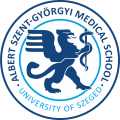2023. June 12.
Professors from Kuala Lumpur, Switzerland and Italy attended the 11th Szeged International Rhinology Days (SZERINA) cadaver dissection course.
Professors from Kuala Lumpur, Switzerland and Italy attended the 11th Szeged International Rhinology Days (SZERINA) cadaver dissection course, organised by the Department of Oto-Rhino-Laryngology and Head-Neck Surgery and the Department of Neurosurgery of the University of Szeged (SZTE) at the Department of Anatomy.
SZTE is the Hungarian pioneer in the field of ENT and neurosurgical care and innovation. In 2007, it was the first health care facility in Hungary to introduce the endoscopic technique for pituitary surgery, which has since been routinely used for malignant nasal and paranasal sinus and skull base operations. Around 100-150 such procedures are performed in the departments of SZTE every year.

’At this international refresher training course in otolaryngology and cranio-maxillofacial surgery lectures and practical tasks help Hungarian and internationally renowned professors, researchers and clinicians in otolaryngological and neurosurgical care and innovation’ said –Dr. Zsolt Bella, Assistant Professor at the Department of Oto-Rhino-Laryngology and Head-Neck Surgery.

He emphasised that the annual course, which was launched in 2011, has in recent years welcomed several well-known and recognised foreign research professors in addition to Hungarian experts and participants. Some of them were participants, while others were invited as lecturers. Just like last year, Prof. Prepageran Narayanan and Prof. Yves Brand were among the keynote speakers in 2023.
’ENT and cranio-maxillofacial surgery has undergone significant development in recent years thanks to advances in technology. These developments mainly concern surgery involving the anterior and middle skull base, which can be performed through the nose using the endoscopic method and medical imaging techniques. The first two days of the course focused on this area. Thanks to our sponsors (Carl STORZ Ltd, Carl ZEISS Ltd, MED-EL Ltd, Sanofi Ltd, Ready Ltd, Replant Med Ltd), the participants were able to try state-of-the-art equipment in a surgical setting. The tasks were performed on special human anatomical specimens provided by the Department of Anatomy. The other two days were spent accessing the ear, areas behind the ear and the posterior skull base. Two people worked at a surgical table, just like in an ordinary operation, one assisting and the other one operating, and after some time they took turns. Often, the teams were paired up in a way that one of them was a neurosurgeon and the other one an ENT specialist - so they could also practise surgical situations they might encounter in everyday life.

As I have mentioned earlier, endoscopic technology and medical imaging have improved a lot recently. With the endoscopic method, in addition to treating inflammatory and cancerous diseases of the paranasal sinuses, we can now perform surgical procedures involving the skull base with much less exploration than traditional surgery, and with less aesthetic and functional deficit. The continuous development of classical surgical techniques, the introduction of new ones and the introduction of new technologies allow surgical teams to choose the optimal method for the patient. Joint training and surgical experience have made it possible for the two teams to approach the tumour from two sides at the same time in special cases,’ said Dr Zsolt Bella.
Neurosurgeons work with a microscope after penetrating the head through the skull, while ENT specialists access the site through the nose with an endoscope. This way, the duration of the surgery, which usually takes 6-8 hours, can be halved, which significantly reduces the strain on the patient and thus improves the chances of recovery.

’This combined simultaneous multiportal approach, which we now use on a regular basis, was one of the first in the world to be carried out in Szeged in 2013. At the same time, a Central and Eastern European centre in the field of ear surgery and cochlear implantation was established at the University, under the leadership of Prof. Dr. József Jóri and Prof. Dr. László Rovó, Rector of SZTE. The key to this professional development is the continuous improvement of the infrastructure, made possible by the construction of the neurosurgical hybrid operating theatre and the new ENT surgical wing. Another essential factor of development is high-level continuing education, made possible by the cooperation between national clinical centres. The cooperation between neurosurgery and ENT surgery in Szeged goes back to 1986, when Professors Bodosi and Czigner founded the Centre,’ concluded Dr Zsolt Bella.











